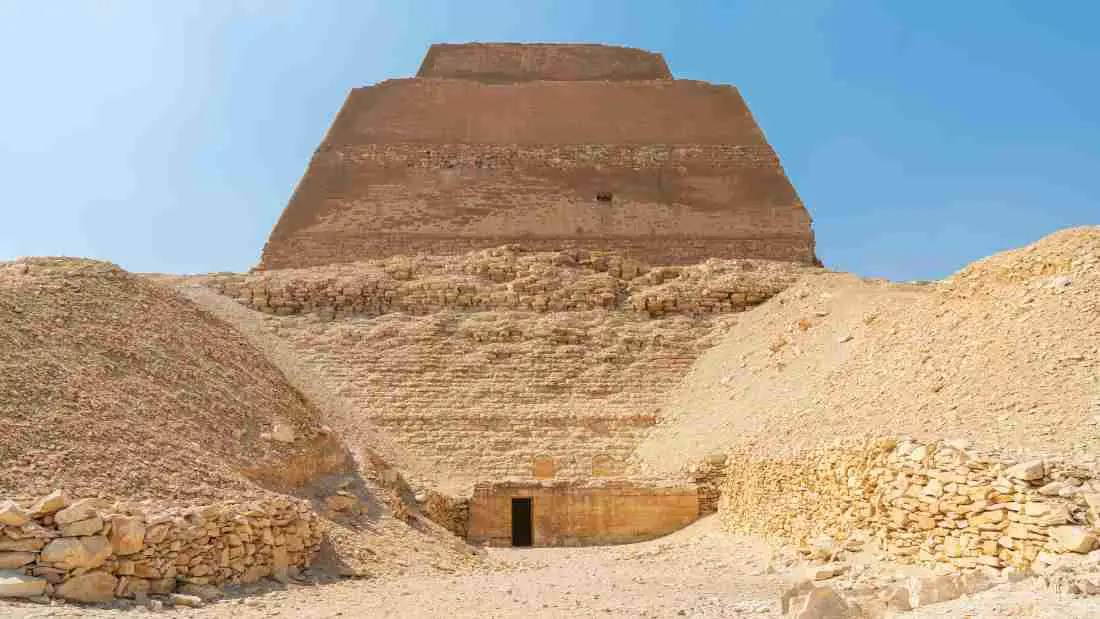When one thinks of ancient Egyptian pyramids, the iconic images of the Great Pyramid of Giza or the Step Pyramid of Djoser often come to mind. However, nestled among Egypt’s rich archaeological landscape lies a lesser-known marvel that is equally captivating – the Meidum Pyramid.

The “Collapsed Pyramid”
Meidum Pyramid, often referred to as the “Collapsed Pyramid” is situated around 100 kilometers south of Cairo.
Constructed for Pharaoh Sneferu, this ancient edifice represents a pivotal transition in pyramid construction during the Old Kingdom period, signifying the evolution from step pyramids to the smooth-sided pyramids that would later grace the Giza plateau.
The appellation “Collapsed Pyramid” stems from the architectural evolution of the structure. Originally built as a step pyramid, the Meidum Pyramid underwent ambitious modifications aimed at transforming it into a more sophisticated design. However, these alterations led to structural instability, resulting in a partial collapse of the pyramid’s outer casing.

A Tomb for a Pharoah
Pharaoh Sneferu, for whom the pyramid was originally constructed, played a pivotal role in ancient Egypt’s architectural and cultural landscape.
As the first pharaoh of the Fourth Dynasty, Sneferu is renowned for his ambitious building projects, overseeing the construction of multiple pyramids across Egypt.
His reign marked a period of significant experimentation and innovation in pyramid construction, exemplified by the unconventional design and subsequent modifications of the Meidum Pyramid.
The architectural legacy of the Meidum Pyramid offers valuable insights into the ancient Egyptians’ relentless pursuit of monumental construction and their mastery of engineering techniques.
This transitional phase in pyramid development not only reflects the ambitious aspirations of Pharaoh Sneferu but also symbolizes the remarkable evolution of ancient Egyptian architecture.

The Architecture of the Meidum Pyramid
The Meidum Pyramid showcases a unique blend of Early Dynastic and Old Kingdom architectural traditions.
The internal structure of the Meidum Pyramid is relatively simple compared to its successors, yet it embodies an innovative design that would set a standard for generations to come.
The entrance, located on the north face above ground level, leads to a descending passage that extends below ground level and culminates in a horizontal passage.
Adjacent to this passage, two small chambers or niches further accentuate the pyramid’s intricate layout. At the conclusion of the passage, a vertical shaft ascends to the burial chamber, ingeniously positioned at ground level.
This groundbreaking approach marked the first instance of a pyramid containing a room within its core, signifying a pivotal architectural milestone.
Notably, the builders utilized the technique of corbelling to address the pressure exerted by the pyramid on the burial chamber. This method involved each course of the chamber’s roof projecting inwards as it ascended, effectively managing the structural demands imposed by the pyramid’s mass.
The burial chamber, measuring 5.9 by 2.65 meters, reflects the builders’ experimental mindset, lacking a sarcophagus and any trace of a burial.
Beyond the pyramid itself, the complex encompasses additional elements that would become standard features of future pyramid complexes.
An eastern chapel, measuring 9.18 by 9 meters, adjoins the pyramid, while a small satellite pyramid to the south, though heavily damaged, attests to the comprehensive nature of the complex.
Traces of an enclosure wall, approximately 236 by 218 meters in dimension, and a limestone-encased causeway further underscore the grandeur and intricacy of the Meidum Pyramid complex.

Conclusion
The remarkable amalgamation of architectural elements in the Meidum Pyramid reflects the transitional phase from Early Dynastic funerary complexes to those of the Old Kingdom, embodying the evolving traditions of ancient Egyptian pyramid construction.
The Meidum Pyramid’s original shape harkens back to the 3rd Dynasty tradition, while its innovative building techniques, satellite pyramid, eastern chapel, and causeway foreshadow the enduring legacy of the Old Kingdom

